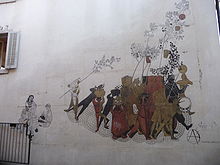Bachfischet
The Bachfischet is a popular custom in the Swiss city of Aarau . It takes place in September on the penultimate Friday before the autumn break.
Origin and process
The city stream , which was built in the 13th century, has to be cleaned once a year. The stream is drained by a barrier above Suhr near the Lettenwiese. The children used to use this opportunity to fish for fish and crabs in the remaining puddles. The cleaning is still done annually in September. Then, after dark, the town stream, which has been let in again, is ceremoniously picked up by the youth (kindergarten to grammar school): by the children with self-made vine lights (or today more modern with tinkered lanterns) on a hazel rod with leaves and by the students from the grammar schools with torches and singing. According to a revived custom, the children of Suhr (where the brook begins) send boats with candles on the freshly cleaned brook to Aarau. The procession through the darkened city goes along the stream bed, even if it has overturned to a significant extent today.
In the end, there is the Aarau Schachen fireworks, ending with the murder-Chlapf , a large single cannon shot .
Descriptions of the brook fish in the 19th century
In 1820 Karl Gottlieb Reinhard Oehler (later founder of the company, at that time professor at the canton school ) describes the Bachfischet for the first time, as a Biedermeier festival: "Walk to the springs ... and to the nearest inn, where baked trout is eaten and lots of wine is drunk."
In 1841, Andreas Dietsch (Bürstenbinder in Aarau, writer, social politician, founder of the communist colony Neu-Helvetia in Missouri) published a first edition of his poetry about the Aarau custom of the stream cutting in detail. A second edition appears in the same year. The third edition, revised in 1844 shortly before the author left for the United States, does not appear until after his death in 1846.
In 1844, Franz Xaver Bronner (former monk, teacher at the canton school, canton archivist) reported in his description of the canton of Aargau about the Bachfischet: "The festival has turned into a pleasure walk for individual families to Suhr."
Bach fish verses
The children scream, ancient verses in the night-black sky, the two read:
A few decades ago the saying was even less gender neutral, the second part read:
De Bach chonnt, de Bach chonnt,
send mini Buebe'n 'alli gsond?
Yo! Yo! Yo!
It was then adapted in line with the times by replacing Buebe with Meitli .
German translation
The brook is there, the brook is there
are all my boys there?
Yes! Yes! Yes!
The brook has come, the brook has come, did
all my girls come?
Yes! Yes! Yes!
Feurio , the brook is burning
The people of Suhr set it on fire ,
The people of Aarau put it out.
The Küttiger , the Küttiger
ride on the frogs.
Older variant of the first verse:
The brook is coming, the brook is coming,
are all my boys healthy?
Yes! Yes! Yes!
Küttiger frogs
A küttiger frog is a special type of sled that is rarely used. In Küttigen itself there are so-called "frog races", in which people slide down a hill with them.


